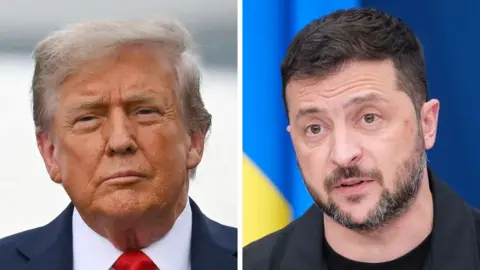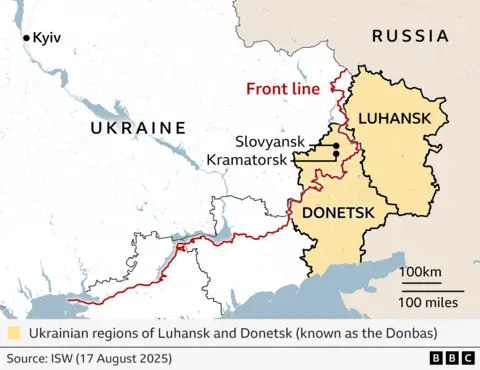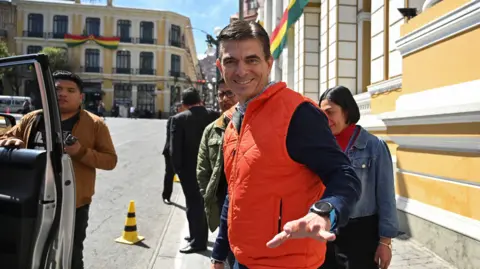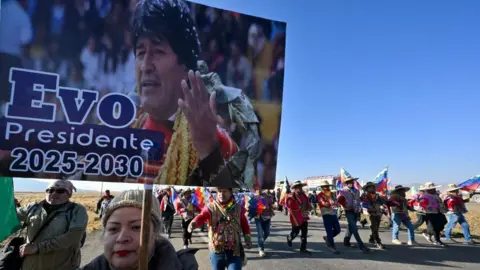A required part of this site couldn’t load. This may be due to a browser
extension, network issues, or browser settings. Please check your
connection, disable any ad blockers, or try using a different browser.
A required part of this site couldn’t load. This may be due to a browser
extension, network issues, or browser settings. Please check your
connection, disable any ad blockers, or try using a different browser.
BBC News
 AFP via Getty Images
AFP via Getty ImagesIt promises to be a day unlike any other at the White House later, when world leaders make a rare collective visit for crunch talks on Ukraine.
What had been billed as a meeting between two presidents, Donald Trump and Volodomyr Zelensky, has now become more of a summit.
Leaders from the UK, France, Germany, Italy, Finland, the EU and Nato have dashed across the Atlantic to have their say on how the three-year-old war with Russia should end and on what terms.
It’s a reflection of how high the stakes are and increased European concerns that the US has shifted its position to one less favourable to Ukraine.
We break down what each of those present – and one who is not – would regard as a win when the sun sets on a long day of talks.
Trump’s campaign promise was that he would solve this conflict on his first day in office but six months later the breakthrough he wants still eludes him.
The terms of any agreement have seemed less important to Trump than the deal itself, so the conditions have shifted over time.
Since meeting Russian President Vladimir Putin in Alaska on Friday, Trump appears to have ditched his criticism of Moscow and the threat of sanctions, and decided to pile the pressure on Zelensky instead.
In a late Sunday night social post, he warned the Ukrainian president he must forgo hopes of Nato membership and will have to concede Crimea, which Putin illegally annexed in 2014.
Trump’s envoy Steve Witkoff said on Sunday that Washington would provide security guarantees to Europe aimed at deterring further Russian aggression. But the details remain unclear.
Up to now, the US has resisted European demands that it commits to the future security of Ukraine. All eyes will be on the White House later to see if that has really changed.
Zelensky finds himself in the unenviable position of having to stand his ground in the face of an increasingly impatient Donald Trump, who appears to have been swayed by Putin and who has already accused Zelensky of standing in the way of peace.
Trump will probably tell Zelensky he must agree to give up land. This will be extraordinarily difficult for the Ukrainian president to give in to as it would entrail retreating from Donetsk and Luhansk, regions which thousands of Ukrainian soldiers have fought and died to protect since 2022.
It would also allow Russia to end up in control of huge swathes of territory it could later use as a launchpad for further aggression.
So Zelensky cannot agree to land concessions without strong security guarantees that would kick in should Russia attack again. Those could have been provided by Nato, but Trump has made it clear Ukraine will not join the alliance.
Details of any alternative guarantees have likely not been worked out yet, but without them it will be difficult for Zelensky to make any commitments.
Ukraine is also concerned by the fact that Trump seems to have moved on from wanting a ceasefire to pushing for a full peace deal. This could take an exceptionally long time, allowing in the meantime for continued Russian attacks, civilian deaths and frontline losses.

European leaders will be trying to push Trump to flesh out what US security guarantees for Ukraine could look like.
The vagueness of US statements on the matter is alarming to Europeans who feel protection from potential future attacks by Russia will have to come from a credible American commitment.
There is also nervousness around the idea that the US may insist Ukraine gives up land to Russia. The European continent has a long history of bloody wars and leaders want to avoid a scenario in which a sovereign country’s borders are redrawn by force.
These serious concerns explain the unprecedented decision for such a large contingent of leaders to visit the White House at the last minute.
Last week, a virtual US-EU meeting ahead of the Alaska summit seemed to have the effect of hardening Trump’s criticism of Russia; now that he is appearing to be teetering on Moscow’s side again, European leaders will try to impress on him that their concerns about the continent’s long-term security have not changed.
There will be no Russian representative at the White House today. That may not matter: it appears Putin made enough of an impression on Trump last week that Moscow may be confident its point of view will be adequately represented.
Trump has already stated Ukraine would not join Nato – and Russia wants that commitment reiterated and ratified. It also wants full control over the Donbas, which would entail Kyiv giving up the land it still holds in the Donetsk and Luhansk regions.
Perhaps most importantly Moscow has managed to instil in Trump that it is now up to Zelensky to make a deal to end the war – while knowing fully well he cannot agree to ceding territory outright. A win for Russia would be for this friction to lead to Trump walking away from the negotiating table for good and leaving Ukraine and the Europeans to fend for themselves.

Form 6K Trident Digital Tech Holdings Ltd ADR For: 18 August
new video loaded: Passengers Stranded as Air Canada Flight Attendants’ Strike Continues
transcript
transcript
“What do we want?” “Fair pay.” “Forced to fly, we won’t comply.” “Air Canada pays our junior flight attendants so little we had to open food banks in our union offices.” ♫ [O Canada] ♫ “They try to put us in another flight, but there is no surety.” “We’re left either stranded in Toronto or to rebook ourselves.” “I don’t have money. This is my last day here in Canada. I am a tourist.” “One day stronger.” “Shame, shame.” “What do we want?” “Fair wages.”
Recent episodes in Americas
The dramatic increase in India’s purchases of Russian oil since the invasion of Ukraine is “opportunistic and deeply corrosive” of a global effort to isolate the Kremlin and curb Vladimir Putin’s war machine, White House trade adviser Peter Navarro wrote in the Financial Times.
In a strongly worded column, Navarro—long a hawkish voice and now an important force behind Donald Trump’s punitive global tariff—linked India’s trade barriers and what he characterized as its financial support for Russia, depicting dealings that come at the expense of the U.S.
“American consumers buy Indian goods,” he said. “India uses those dollars to buy discounted Russian crude.”
India’s External Affairs Ministry didn’t respond to an email seeking comment on Navarro’s column. The South Asian country has defended its right to buy oil from the cheapest source. The threat of penalties and additional tariffs for buying Russian crude is “unreasonable” and “extremely unfortunate,” Randhir Jaiswal, a foreign ministry spokesperson, said earlier this month.
Historically, India hasn’t been a significant importer of Russian crude, depending more heavily on the Middle East. That changed in 2022, after the invasion of Ukraine and a $60-per-barrel price cap imposed by the Group of Seven nations that aimed to limit the Kremlin’s oil revenue while keeping supplies flowing globally. India’s ability to purchase discounted cargoes was a feature of that mechanism acknowledged by U.S. officials.
Russia accounted for a negligible portion of India’s total imports in 2021, and the country has tended to depend far more heavily on the Middle East. Today, Russia makes up around 37% of imports, according to data analytics firm Kpler.
“This surge has not been driven by domestic oil consumption needs. Rather, what really drives this trade is profiteering by India’s Big Oil lobby,” Navarro said. “In effect, India acts as a global clearinghouse for Russian oil, converting embargoed crude into high-value exports while giving Moscow the dollars it needs.”
He also took a swipe at India’s oil tycoons and their ties to the government. Reliance Industries Ltd., owned by billionaire Mukesh Ambani, has been among the buyers of Russian crude. It has bought cargoes under long-term contracts.
“The proceeds flow to India’s politically connected energy titans, and in turn, into Vladimir Putin’s war chest,” Navarro said.
In the last few weeks, Trump has hit India with a 50% tariff rate—far higher than it placed on regional peers, partly to punish New Delhi for its Russian purchases. The doubling of an original levy comes into effect next week.
“This two-pronged policy will hit India where it hurts—its access to U.S. markets—even as it seeks to cut off the financial lifeline it has extended to Russia’s war effort,” Navarro said. “If India wants to be treated as a strategic partner of the U.S., it needs to start acting like one.”
India is the only major economy to be hit with what Trump calls “secondary tariffs”, though Beijing buys more of Moscow’s crude overall. Trump—eager to slash the U.S.’s trade deficit with India—has floated the possibility of higher levies on China over its Russian purchases, Navarro has downplayed that possibility, suggesting higher levels would hurt the U.S. economy.
By Anya Pelshaw on SwimSwam

Fitter and Faster Swim Camps is the proud sponsor of SwimSwam’s College Recruiting Channel and all commitment news. For many, swimming in college is a lifelong dream that is pursued with dedication and determination. Fitter and Faster is proud to honor these athletes and those who supported them on their journey.
Tomer Shuster has announced his commitment to continue his academic and athletic careers at Kentucky. He will join the team in January 2026.
Shuster represents Israel at the international level and most recently competed at the 2025 World Championships in Singapore. There he swam in prelims of the 50 back, swimming a 25.34 for 33rd. His lifetime best is a 24.97 from May at Israel’s World Championship Trials.
The Kentucky men finished 9th out of 11 teams at the 2025 SEC Championships and went on to finish 20th at 2025 NCAAs. Ryan Merani led the team at SECs and was highlighted by a 5th place finish in the 200 butterfly.
The team just finished its second season under head coach Bret Lundgaard. This offseason, the team hired Matt Martinez, Cauli Bedran, and Karissa Kruszewski and has had success bringing in recruits, especially at the international level. Martinez is the team’s recruiting coordinator.
Based on his best converted times, Shuster would have been 5th on the team this past season in the 100 backstroke. His 50 back best converted time would have been 2nd, just behind Devin Naoroz who led the team’s 200 medley relay off at SECs in a 21.49.
Although he will not arrive until the spring, Shuster is a member of the recruiting class entering in the 2025-2026 season. It is an international heavy class that also includes Lithuania’s Dziugas Miskinis, Falemana Lopez Tuufui and Lysander Osman of France, as well asGabriel Perdigao Vieira de Barros from Brazil.
If you have a commitment to report, please send an email with a photo (landscape, or horizontal, looks best) and a quote to Recruits@swimswam.com.
About the Fitter and Faster Swim Tour
Fitter & Faster Swim Camps feature the most innovative teaching platforms for competitive swimmers of all levels. Camps are produced year-round throughout the USA and Canada. All camps are led by elite swimmers and coaches. Visit fitterandfaster.com to find or request a swim camp near you.
FFT SOCIAL
Instagram – @fitterandfasterswimtour
Facebook – @fitterandfastertour
Twitter – @fitterandfaster
FFT is a SwimSwam partner.
Read the full story on SwimSwam: 2025 Worlds Swimmer Tomer Shuster Of Israel Joining Kentucky In January 2026
If you’ve walked along the beach barefoot at the end of a hot day, you’ll know that sand retains heat well. For example, a container with one kilogram of sand takes more than five hours to go from 40°C to 20°C. This is due to the low heat transfer coefficient of silicon dioxide, the main component of sand. And that is the principle behind an innovative sand battery recently installed in Finland to store green power throughout the harsh Scandinavian winter.
There are currently numerous renewable energy storage projects, some more fanciful, such as gravity systems, and others already operational, such as this pilot project based on recycled electric batteries from cars installed in a photovoltaic plant in Navarra. Now the sand batteries complement these experiences with a promising alternative approach.
Markku Ylönen and Tommi Eronen are two Finnish researchers who have set out to create what is touted to be the first commercial sand battery. The initial aim was to compensate for the intermittency of renewable energy sources such as wind and solar power by converting surplus electricity production into heat. To this end, they have accumulated 100 tons of sand in a silo with insulating materials installed next to a power plant.
This sand battery uses resistive heating, also known as the Joule effect, whereby electrons flowing through a resistor generate heat, as in a toaster or stove. Subsequently, the hot air generated is circulated through a heat exchanger, which transfers the heat to the sand. The developers claim temperatures above 500°C can be reached, storing up to 8 MWh.
The battery is already in operation and supplies heat to residential buildings, offices, and even a public swimming pool in the Finnish town of Kankaanpää. This battery is capable of storing heat from renewable energy for months. In the case of sand, using the heat directly is more efficient than converting it back into electricity, as a lot of energy is lost in the process. Once the feasibility of the project has been demonstrated, the next step is to create a thousand times larger battery to move towards a more sustainable energy system.
Across the pond, in the USA, NREL (the National Renewable Energy Laboratory) is working on a more ambitious prototype, although based on the same principles as its Finnish counterpart. The innovative battery, dubbed ENDURING, could reach a storage capacity of up to 26,000 MWh. But how exactly does it work?
In this case, gravity is added to the equation. NREL’s prototype uses conveyor belts that lift the sand onto heating elements that heat it to 1200º C for storage in silos, like dropping sand through the heating elements of a toaster. When power is needed, the particles are gravity-fed through heat exchangers to power steam turbines that generate electricity fed back into the grid.
In an article about the ENDURING prototype, the U.S. laboratory points out that sand is a stable, low-cost material, with a price ranging from thirty to fifty dollars per ton, and a low ecological impact in its extraction and at the end of its useful life. It also points out that although thermal energy storage has a lower density, its cost can be as low as two dollars per kWh.
As they are used as heat accumulators, sand batteries are not as versatile as other technologies such as lithium, but in return, they offer numerous advantages:
Sand batteries are part of a new wave of large-scale electricity storage systems, such as liquid batteries. You can read more about these types of technologies in this article or subscribe to our newsletter at the bottom of this page to keep up with the latest news.
Source:
Early results showed centrist Rodrigo Paz take the lead, with 32.8 percent of the vote, in surprise outcome.
Bolivia is heading to a presidential run-off between a centrist and right-wing candidate, confirming the end of two decades of government by the Movement for Socialism (MAS), according to the South American country’s electoral council.
With more than 91 percent of the ballots counted on Sunday night, preliminary results showed centrist Rodrigo Paz of the Christian Democratic Party (PDC) in the lead, with 32.8 percent of the vote.
Conservative former interim President Jorge “Tuto” Quiroga, of the Alianza Libre coalition, was in second place, with 26.4 percent of the vote, meaning he will face Paz, the son of former left-leaning President Jaime Paz, in a run-off election on October 19.
Candidates needed to surpass 50 percent, or 40 percent with a 10-point margin of victory, to avoid a run-off.
Al Jazeera’s Latin America editor Lucia Newman, reporting from Bolivia’s Santa Cruz de la Sierra, said the early results confirmed that MAS, which has governed the country since 2005, is “out of the picture”.
But the “biggest surprise”, Newman said, is “that the frontrunner is none other than somebody who was polling between fourth and fifth place up until now”.
Paz is “more to the centre” than his father, Newman added.
Eight presidential candidates were in the running in Sunday’s presidential election – from the far-right to the political left.
Pre-election polls had shown Samuel Doria Medina, a wealthy businessman and former planning minister, as one of two frontrunners alongside Quiroga, who served as interim president and vice president under former military leader President Hugo Banzer.
Former leftist President Evo Morales was barred from running, and the outgoing socialist President Luis Arce, who had fallen out with Morales, opted out of the race.
The division within their leftist coalition, along with the country’s deep economic crisis, meant few expected MAS to return to power.
Official results are due within seven days. Voters will also elect all 26 senators and 130 deputies, and officials assume office on November 8.
The Andean country has been struggling through its worst economic crisis in a generation, marked by annual inflation of almost 25 percent and critical shortages of US dollars and fuel.
Bolivians repeatedly took to the streets to protest rocketing prices and hours-long waits for fuel, bread and other basics in the lead-up to Sunday’s election.
Bolivia enjoyed more than a decade of strong growth and Indigenous upliftment under Morales, who nationalised the gas sector and ploughed the proceeds into social programmes that halved extreme poverty during his stint in power between 2006 and 2019.
But a lack of new gas projects under Morales, who was outspoken on environmental issues and climate change, has seen gas revenues plummet from a peak of $6.1bn in 2013 to $1.6bn last year.
With the country’s other major resource, lithium, still underground, the government has nearly run out of the foreign exchange needed to import fuel, wheat and other foodstuffs.
A required part of this site couldn’t load. This may be due to a browser
extension, network issues, or browser settings. Please check your
connection, disable any ad blockers, or try using a different browser.
South America correspondent, BBC News
 Reuters
ReutersBolivia is set to elect a non-left wing president after nearly two decades of near-continuous rule by the incumbent socialist party, according to official preliminary results.
Senator Rodrigo Paz Pereira and former president Jorge Quiroga came in first and second place respectively in Sunday’s presidential elections.
Neither received a high enough share of the vote to secure an outright win, so the vote will go to a run-off between these two candidates, due in October.
Paz Pereira, of the Christian Democratic Party, was a surprise vote leader, after opinion polls had suggested Samuel Doria Medina, a businessman, was the frontrunner.
The electoral authorities said it can take up to three days to finalise the results.
Paz Pereira’s campaign focused on redistributing more funds away from central government towards regional entities, and fighting corruption – with his slogan “capitalism for all, not just a few”.
He has suggested a programme of accessible credit, tax breaks to boost the formal economy, and eliminating import barriers for products that Bolivia doesn’t manufacture.
Quiroga briefly acted as interim president from 2001-2002 after serving as Vice President to Hugo Banzer, a military dictator until he was later elected.
The election of a president from outside the left camp will likely see sharp changes in the Latin American country’s foreign policy.
In terms of trade, both candidates capitalist stances could indicate more support for foreign investment in Bolivia’s vast lithium reserves – the key ingredient for batteries used in many electric cars, laptops and solar panels.
Politically, a change in government could mark closer ties with the US, after two decades of strengthening ties between Bolivia and China, Russia and Iran.
A recent US Congress report briefing described US-Bolivia relations as “strained” under the socialist party’s governance.
 Reuters
ReutersThe country’s turn to the right comes as it is experiencing its worst economic crisis in years, with shortages of fuel, foreign reserves and some food items and high inflation and debt.
Opinion polls ahead of the election suggested that many voters wanted to vote for change, or to punish the incumbent Movimiento al Socialismo (MAS) party.
The current president, Luis Arce, mired in deep unpopularity, decided not to seek re-election.
The punishment of the left is not just electoral, but physical in some cases.
The candidate for MAS, Eduardo del Castillo, was booed out of the school where he cast his vote. Bolivian media reported that some fellow voters told him to “wait in line like they do for fuel” rather than skip the voting queue.
People also threw stones at the highest-polling left-wing candidate, Andrónico Rodríguez, when he went to cast his ballot. Rodríguez was previously a member of MAS before splintering from the party.
Authorities in Bolivia also said that an explosive device was set off at the polling station where Rodríguez cast his vote. There were no reports of significant damage or injuries.
Rodríguez described it as an “isolated incident” orchestrated by a “small group” to a Bolivian newspaper.
The left has not just faced recent unpopularity over the economy. It is also deeply divided.
 AFP via Getty Images
AFP via Getty ImagesFor the first time in about two decades, the former president, Evo Morales, was not on the ballot.
Morales ruled the country from 2006-2019 and was barred from running again, despite attempts to challenge legal and constitutional rulings to let him run for a fourth term.
He has urged his supporters to null their vote.
Rodríguez was once seen as a protégé of Morales, but has since distanced himself from him.
The last election in 2019 was disputed and protests erupted. Morales was accused of fraud after auditors found irregularities with the poll and he resigned under pressure from the military.
In 2020, Luis Arce – a former finance minister under Morales – took office as president. Morales then announced he would return to politics in Bolivia, and deprived Arce of a majority – turning the pair from allies to rivals.
Deep rifts and power struggles have existed in the ruling MAS party ever since. Morales’s supporters have held protests and roadblocks against the re-election ban imposed on him, which have at times turned deadly with some emergency responders being killed.
Judges ordered an arrest warrant for Morales over an alleged sexual relationship and rape of a 15-year-old girl. He has called the accusations politically-motivated.
He has been living and operating from Chapare in Bolivia, protected at times by his supporters.